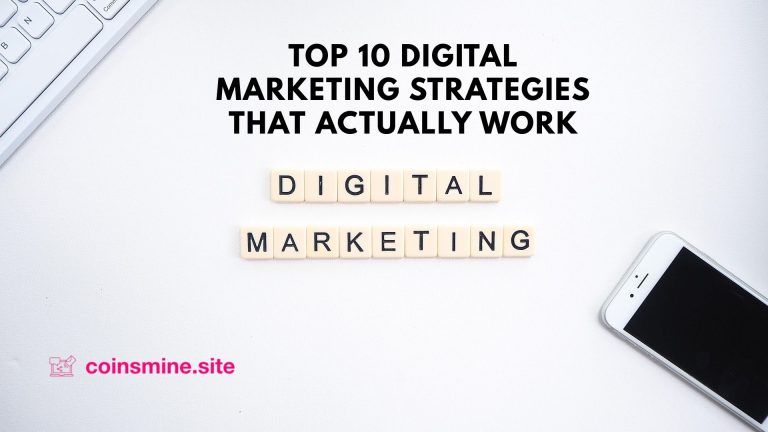Top 10 Digital Marketing Strategies That Actually Work: In the current fiercely competitive digital environment, merely maintaining an online presence is insufficient. To differentiate themselves, companies require strategic marketing approaches that effectively engage the appropriate audience. Ranging from SEO to social media and email marketing, digital marketing provides a multitude of tools designed to enhance your brand and increase sales.
But which strategies are most effective? In this article, we will examine the ten best digital marketing tactics that reliably generate traffic, engagement, and conversions—tactics that companies of any scale can adopt to attain measurable results in 2025 and the years to come.
Top 10 Digital Marketing Strategies That Actually Work
In the current rapid digital landscape, companies require more than simply an online presence to remain competitive. Regardless of whether you’re managing a small startup or a large international company, an effective digital marketing plan can assist you in drawing in new clients, enhancing brand recognition, and boosting income. However, with numerous choices available, which methods yield real results? Here are the ten most effective digital marketing strategies for 2025.
(1) Search Engine Optimization (SEO).
One of the most effective long-term tactics in digital marketing is still SEO. By fine-tuning your site and content for pertinent keywords, you can achieve better rankings on search engines such as Google and draw in organic traffic. Contemporary SEO encompasses more than just keywords—it also involves site speed, mobile optimization, backlinks, and producing high-quality content.
(2) Content Marketing.
Content serves as the foundation of digital marketing. An effective content marketing strategy includes producing blog articles, videos, infographics, podcasts, and various other formats that inform, engage, or address the issues faced by your audience. High-quality content fosters trust and establishes authority, resulting in enhanced customer loyalty and higher conversion rates.
(3) Social Media Marketing.
Social media platforms such as Instagram, Facebook, LinkedIn, TikTok, and X (previously known as Twitter) are crucial for engaging with brands. Customizing your message for every platform and utilizing an appropriate balance of organic and paid content enables businesses to effectively and consistently connect with their desired audiences.
(4) Email Marketing.
Even though it’s one of the oldest tactics in online marketing, email marketing still produces a significant return on investment. Customized email campaigns, automated series of messages, and newsletters serve as effective methods for cultivating leads, keeping customers engaged, and increasing repeat sales.
(5) Pay-Per-Click Advertising (PPC).
PPC advertising—particularly via platforms such as Google Ads and Meta Ads—provides quick visibility and traffic that is highly targeted. Whether through search ads, display ads, or retargeting campaigns, PPC can swiftly generate leads and sales when properly optimized.
(6) Influencer Marketing.
Collaborating with influencers who have an established rapport with your desired audience can enhance engagement and build trust. Micro-influencers (those with 10k–100k followers) frequently yield a superior return on investment compared to celebrity endorsements due to their specialized focus and highly interactive communities.
(7) Video Marketing.
Video content leads the way on digital platforms. Short videos (such as those on TikTok or Reels), instructional tutorials, product demonstrations, and live broadcasts all contribute to making your brand feel more relatable and boost user interaction. YouTube, as the second-largest search engine, is particularly effective for visibility and discovery.
(8) Affiliate Marketing.
Affiliate marketing enables individuals to advertise your products for a commission. This is a performance-driven approach that reduces initial expenses and can greatly broaden your marketing outreach if you collaborate with suitable affiliates.
(9) Marketing Automation.
You can automate time-consuming processes like email marketing, lead scoring, and social media postings with platforms like HubSpot, Mailchimp, and ActiveCampaign. Automation helps save time, guarantees uniform communication, and enhances conversion rates by creating personalized customer experiences.
(10) Data Analytics and Conversion Rate Optimization (CRO).
Digital marketing goes beyond mere traffic; it’s centered on results. Utilizing analytics platforms such as Google Analytics, Hotjar, or Mixpanel allows you to assess user activity and determine what is effective and what requires enhancement. To increase the number of visitors who become customers, Conversion Rate Optimization (CRO) seeks to enhance your landing pages, calls to action (CTAs), and funnels.
Final Thoughts.
The landscape of digital marketing is always changing, but the fundamental tactics that yield tangible results are always the same. By combining a few of these strategies, which are customized to your audience and business objectives, you can build a strong online presence, generate qualified leads, and expand sustainably in a cutthroat market.



